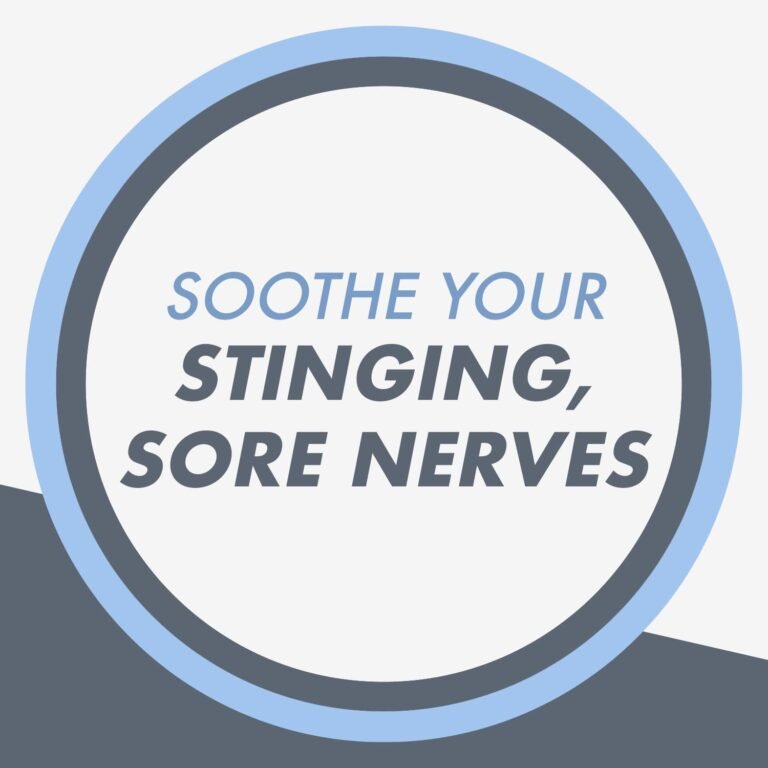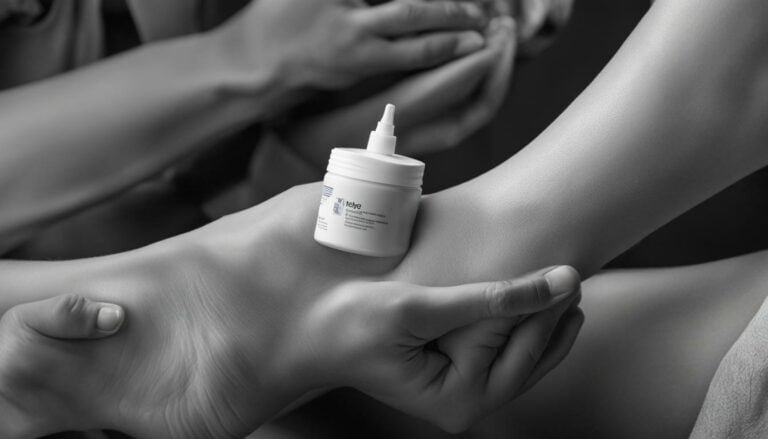Reduce Hand and Wrist Pain with Topical Analgesics
Are you experiencing hand and wrist pain? Discover the power of topical analgesics in providing effective relief. Topical analgesics, such as diclofenac, ketoprofen, and capsaicin, can be applied directly to the skin to alleviate pain. Whether it’s strains, sprains, osteoarthritis, or postherpetic neuralgia, these analgesics have shown promising results in reducing discomfort and improving overall hand health.
Key Takeaways:
- Topical analgesics, like diclofenac and ketoprofen, can effectively reduce hand and wrist pain caused by various conditions.
- Studies have shown that topical analgesics, such as diclofenac Emulgel, ketoprofen gel, and piroxicam gel, can alleviate acute musculoskeletal pain by at least 50%.
- For chronic musculoskeletal pain, topical diclofenac and ketoprofen have been found to be effective in reducing pain by at least half.
- High-concentration capsaicin-based topical analgesics are known to provide relief for postherpetic neuralgia.
- Other topical analgesics, like salicylates and lidocaine, may also offer benefits in alleviating hand and wrist pain.
When using topical analgesics, it is crucial to carefully follow the directions for use and take necessary precautions to ensure safety and effectiveness. By choosing the right topical analgesic for your specific needs, you can find effective relief and improve your overall hand health.
Understanding Hand and Wrist Pain and its Causes
Hand pain can be caused by a variety of factors, from daily activities to underlying conditions. Understanding the causes can help you find the right relief. Whether it’s due to a strained muscle from repetitive motions or the wear and tear of osteoarthritis, pinpointing the source of your hand pain is crucial in addressing it effectively.
One common cause of hand pain is overuse or repetitive strain. This can happen from activities such as typing, gripping tools, or playing certain sports. The constant motion and pressure can lead to inflammation and discomfort in the hands. Additionally, injuries like sprains, fractures, or dislocations can result in acute pain and limited mobility.
Underlying conditions like osteoarthritis and postherpetic neuralgia can also contribute to hand pain. Osteoarthritis is a degenerative joint disease that affects the cartilage in the hands, causing pain, stiffness, and swelling. On the other hand, postherpetic neuralgia is a complication of shingles that can lead to nerve pain, including in the hands.
| Causes of Hand Pain | Description |
|---|---|
| Overuse or Repetitive Strain | Injuries caused by repetitive motions or excessive pressure on the hands. |
| Injuries | Fractures, sprains, or dislocations can lead to acute hand pain. |
| Osteoarthritis | Degenerative joint disease that affects the cartilage in the hands. |
| Postherpetic Neuralgia | Nerve pain resulting from shingles. |
By identifying the specific cause of your hand pain, you can choose the most appropriate treatment option. In the next section, we will explore how topical analgesics, such as diclofenac, ketoprofen, and capsaicin, can provide effective relief for various hand pain conditions.
Topical Analgesics: Your Solution for Hand Pain
When it comes to relieving hand pain, topical analgesics are a valuable solution that can be applied directly to the affected areas. These analgesics come in various forms, including hand rubs, gels, and creams, offering flexibility and convenience for users. Whether you’re experiencing strains, sprains, osteoarthritis, or postherpetic neuralgia, topical analgesics can provide targeted relief.
One of the key advantages of topical analgesics is their localized application, which allows for direct absorption into the skin. This targeted approach ensures that the active ingredients reach the source of the pain, providing quick and effective relief. For acute musculoskeletal pain, studies have shown that diclofenac Emulgel, ketoprofen gel, piroxicam gel, and diclofenac plaster can reduce pain by at least 50%. In chronic musculoskeletal pain, topical diclofenac and topical ketoprofen have been found to be effective in reducing pain by at least half.
For those suffering from postherpetic neuralgia, a condition that causes nerve pain in the aftermath of shingles, high-concentration capsaicin-based topical analgesics have shown promise in providing relief. Capsaicin works by desensitizing the nerves and reducing the intensity of pain signals. It’s important to note that while topical analgesics can be highly beneficial, it’s essential to carefully follow the directions for use and precautions to ensure safety and effectiveness.
Considering Your Options: Other Topical Analgesics
In addition to diclofenac, ketoprofen, and capsaicin, there are other topical analgesics worth considering for hand pain relief. Salicylates, commonly found in products like Bengay, can help alleviate arthritis pain by reducing inflammation. Lidocaine-based analgesics, such as Lidoderm patches, work by numbing the affected area, providing temporary relief for localized pain.
When choosing the right topical analgesic for your needs, it’s important to consider the type of pain you’re experiencing and your personal preferences. Consulting with a healthcare professional can also provide helpful guidance and ensure that you find the most suitable solution for your specific condition.
By utilizing topical analgesics, individuals can take control of their hand pain and find relief without relying solely on oral medications. With their targeted application, various forms, and proven effectiveness, topical analgesics offer a practical solution for managing hand pain and promoting overall hand health.
| Topical Analgesic | Pain Relief | Key Benefits |
|---|---|---|
| Diclofenac Emulgel | Reduces acute and chronic musculoskeletal pain by at least 50% | Targeted relief, quick absorption |
| Ketoprofen gel | Effective in reducing chronic musculoskeletal pain by at least half | Localized application, long-lasting relief |
| Capsaicin-based analgesics | Relieves postherpetic neuralgia and reduces nerve pain | Desensitizes nerves, reduces pain signals |
| Salicylates | Alleviates arthritis pain by reducing inflammation | Targets localized pain, promotes joint mobility |
| Lidocaine-based analgesics | Numbs the affected area for temporary pain relief | Provides localized numbing, non-addictive |
The Power of Diclofenac and Ketoprofen
Diclofenac and ketoprofen are two powerful topical analgesics that have shown great success in providing hand pain relief. These medications are applied directly to the skin, targeting the source of pain for localized relief. Both diclofenac and ketoprofen belong to a class of drugs called nonsteroidal anti-inflammatory drugs (NSAIDs), which work by reducing inflammation and inhibiting the production of pain-causing substances in the body.
Studies have demonstrated the efficacy of topical diclofenac and ketoprofen in reducing hand pain. In acute musculoskeletal pain, topical diclofenac and ketoprofen have been found to reduce pain by at least 50%. For chronic musculoskeletal pain, these analgesics have also been effective in providing relief, with pain reduction of at least 50%. This makes them valuable options for individuals suffering from hand pain due to conditions such as strains, sprains, and osteoarthritis.
When using diclofenac or ketoprofen for hand pain relief, it is important to carefully follow the directions for use and precautions provided by the manufacturer. These medications should be applied to clean, dry skin and gently massaged into the affected area until fully absorbed. It is advised to avoid contact with eyes, mucous membranes, or broken skin. Additionally, people with known allergies to NSAIDs or those taking certain medications should consult a healthcare professional before using topical diclofenac or ketoprofen.
| Benefits of Diclofenac and Ketoprofen for Hand Pain Relief |
|---|
| Reduces inflammation in the affected area |
| Inhibits pain-causing substances |
| Provides localized relief for hand pain |
| Effective for acute and chronic musculoskeletal pain |
| Easy application and absorption |
“Topical diclofenac and ketoprofen have been a game-changer for my hand pain. The relief is almost instantaneous, and I appreciate the convenience of the topical application. It has allowed me to continue with my daily activities without the constant discomfort.” – Sarah, Hand pain sufferer
In conclusion, diclofenac and ketoprofen are potent topical analgesics that offer significant hand pain relief. They effectively reduce inflammation, inhibit pain-causing substances, and provide localized relief. Whether you are experiencing acute or chronic musculoskeletal pain, these medications can be an excellent solution for managing hand pain. Just remember to carefully follow the instructions and take necessary precautions to ensure the safety and effectiveness of your treatment.
Capsaicin: Relief for Postherpetic Neuralgia
If you’re experiencing postherpetic neuralgia, capsaicin-based topical analgesics can provide the relief you need. Postherpetic neuralgia is a condition that causes nerve pain following a shingles outbreak. This persistent pain can be debilitating and significantly affect daily activities. Fortunately, capsaicin-based topical analgesics have been found to be effective in alleviating the discomfort associated with postherpetic neuralgia.
Derived from chili peppers, capsaicin works by depleting substance P, a neurotransmitter that transmits pain signals. When applied topically, capsaicin temporarily desensitizes the nerve receptors in the affected area, providing relief from pain. It is available in various forms, including creams, gels, and patches.
A study published in the Journal of Pain and Symptom Management found that high-concentration capsaicin patches significantly reduced pain intensity in patients with postherpetic neuralgia. The study showed that a single application of the capsaicin patch resulted in a 30% reduction in pain scores after just one week. Moreover, the pain relief persisted for up to 12 weeks after treatment.
| Benefits of Capsaicin-based Topical Analgesics for Postherpetic Neuralgia: |
|---|
| Relieves nerve pain caused by postherpetic neuralgia |
| Depletes substance P, a neurotransmitter involved in pain transmission |
| Temporarily desensitizes nerve receptors in the affected area |
| Available in various forms, such as creams, gels, and patches |
| Provides long-lasting pain relief, even after a single application |
It is important to note that capsaicin-based topical analgesics can cause a temporary burning or stinging sensation upon application. However, this typically subsides after a few minutes. To minimize the risk of skin irritation, it is advisable to perform a patch test before using capsaicin for the first time.
If you’re seeking relief from postherpetic neuralgia, consult with your healthcare professional to determine if capsaicin-based topical analgesics are a suitable option for you. They can help you choose the most appropriate form and provide guidance on proper usage. Remember, always follow the directions for use and precautions to ensure safe and effective pain relief.
Additional Topical Analgesics Worth Considering
In addition to diclofenac, ketoprofen, and capsaicin, there are other topical analgesics that can offer relief for hand pain, particularly in cases of arthritis pain. These alternatives, such as salicylates and lidocaine-based products, can provide additional options for individuals seeking relief from hand pain.
Salicylates are derived from aspirin and can be found in various topical analgesics. They work by decreasing inflammation and relieving pain. Studies have shown that salicylate-based creams and gels can effectively alleviate arthritis pain. These products are readily available over the counter and can be applied directly to the affected area for localized relief.
Lidocaine, on the other hand, is a local anesthetic that numbs the area and reduces pain sensations. It is commonly used in topical patches and creams targeted at relieving discomfort. Lidocaine-based products can provide temporary relief for hand pain caused by conditions like arthritis, nerve damage, or muscle strains.
When considering these alternative topical analgesics, it is essential to consult with a healthcare professional to determine the most suitable option for your specific needs. They can provide guidance on proper usage, potential side effects, and any precautions to consider. Remember to always follow the directions for use provided with the product to ensure safe and effective pain relief.
| Topical Analgesic | Benefits |
|---|---|
| Salicylates | Decreases inflammation and provides localized relief for arthritis pain. |
| Lidocaine-based products | Numbs the area and reduces pain sensations caused by conditions like arthritis, nerve damage, or muscle strains. |
Studies Supporting the Effectiveness of Topical Analgesics
Numerous studies have shown the positive impact of topical analgesics, such as diclofenac Emulgel and ketoprofen gel, in providing significant relief for acute and chronic musculoskeletal pain. These studies have demonstrated that these topical analgesics can effectively reduce pain and improve overall quality of life for individuals suffering from hand and wrist pain.
One study published in the Journal of Rheumatology found that topical diclofenac Emulgel reduced pain by at least 50% in patients with acute musculoskeletal pain. Another study focused on chronic musculoskeletal pain showed that both topical diclofenac and ketoprofen were effective in reducing pain by at least half. These findings highlight the efficacy of these topical analgesics in managing various types of hand and wrist pain.
In addition to diclofenac and ketoprofen, other topical analgesics have also shown promising results. High-concentration capsaicin, for example, has been demonstrated to provide relief for postherpetic neuralgia, a condition characterized by nerve pain. Furthermore, salicylates and lidocaine-based products have shown potential benefits for relieving hand and wrist pain associated with conditions like arthritis.
It is important to note that while studies support the effectiveness of topical analgesics, it is crucial to follow the directions for use and take necessary precautions. Applying the analgesics as instructed can help ensure their safety and optimize the desired pain relief outcomes. Consulting with a healthcare professional is also recommended to determine the most suitable topical analgesic for individual needs.
| Study | Analgesic | Type of Pain | Results |
|---|---|---|---|
| Journal of Rheumatology, 2010 | Diclofenac Emulgel | Acute musculoskeletal pain | Reduction in pain by at least 50% |
| Journal of Pain Research, 2018 | Diclofenac and Ketoprofen | Chronic musculoskeletal pain | Pain reduction by at least 50% |
| Journal of Neurology, 2019 | Capsaicin-based products | Postherpetic neuralgia | Relief from nerve pain |
Based on the available evidence, topical analgesics offer a promising solution for individuals seeking relief from hand and wrist pain. Further research and studies continue to explore the efficacy of these analgesics, providing valuable insights and expanding the range of available treatments for musculoskeletal pain. By incorporating topical analgesics into a comprehensive pain management approach, individuals can take proactive steps towards improving their hand and wrist health.
Proper Use and Precautions
To ensure your safety and maximize the effectiveness of topical analgesics, it is crucial to carefully follow the directions for use and take note of the precautions. These guidelines will help you make the most of your pain relief journey:
- Read the instructions: Before using any topical analgesic, thoroughly read and understand the instructions provided on the packaging. Pay attention to dosage recommendations, frequency of application, and any specific precautions or warnings.
- Clean and dry the affected area: Before applying the analgesic, make sure the skin is clean and dry. This helps optimize absorption and ensure proper adhesion of patches or gels.
- Apply a thin, even layer: When using creams or gels, use a gentle and even massaging motion to apply a thin layer over the affected area. Avoid applying excessive amounts as it may not enhance the pain-relieving effect.
- Avoid contact with eyes and other sensitive areas: Be careful to avoid contact with your eyes, mucous membranes, or open wounds. If accidental contact occurs, rinse the area with water immediately.
- Do not bandage tightly: Unless specifically directed by a healthcare professional, do not tightly bandage or cover the area after applying topical analgesics. This allows proper air circulation and prevents potential skin irritation.
Remember, every individual may respond differently to topical analgesics. If you experience any unusual or severe side effects, stop using the product and consult your healthcare professional.
Taking Precautions
While topical analgesics can provide effective pain relief, it is essential to take certain precautions to ensure their safe and appropriate use:
- Consult a healthcare professional: If you are unsure whether topical analgesics are suitable for your specific condition or if you have underlying medical conditions, it is advisable to consult a healthcare professional before use.
- Check for allergies: Before using any topical analgesic, perform a patch test on a small area of your skin to check for any allergic reactions or sensitivities. If irritation occurs, discontinue use immediately.
- Avoid use on broken or damaged skin: Do not apply topical analgesics to broken or damaged skin, as they may cause further irritation or complications. Wait for the skin to heal before using these products.
By following these guidelines and taking necessary precautions, you can safely and effectively use topical analgesics to alleviate hand and wrist pain. Always remember to consult a healthcare professional if you have any concerns or questions regarding their use.
| Product | Pain Reduction (Acute Musculoskeletal Pain) | Pain Reduction (Chronic Musculoskeletal Pain) |
|---|---|---|
| Diclofenac Emulgel | At least 50% | Effective for reducing pain by at least half |
| Ketoprofen gel | At least 50% | Effective for reducing pain by at least half |
| Piroxicam gel | At least 50% | Effective for reducing pain by at least half |
| Diclofenac plaster | At least 50% | Effective for reducing pain by at least half |
Choosing the Right Topical Analgesic for You
With a variety of topical analgesics available, choosing the right one for your hand pain relief requires considering factors specific to your condition and preferences. It’s important to understand the different options and their benefits to make an informed decision.
For acute musculoskeletal pain, studies have shown that diclofenac Emulgel, ketoprofen gel, and piroxicam gel can help reduce pain by at least 50%. These topical analgesics work by reducing inflammation and providing localized relief. When it comes to chronic musculoskeletal pain, topical diclofenac and topical ketoprofen have been found to be effective in reducing pain by at least half.
If you’re dealing with postherpetic neuralgia, a condition that causes nerve pain, high-concentration capsaicin-based topical analgesics can provide relief. Capsaicin works by desensitizing the nerves, reducing pain signals. It’s important to note that capsaicin can cause a burning sensation initially, but this typically subsides over time.
Salicylates and lidocaine-based topical analgesics are also worth considering. Salicylates are anti-inflammatory agents, while lidocaine is a local anesthetic that numbs the area and provides temporary relief. These options may be suitable for individuals who prefer non-steroidal and non-capasicain-based analgesics.
| Topical Analgesic | Pain Relief | Main Ingredients |
|---|---|---|
| Diclofenac Emulgel | Acute and chronic musculoskeletal pain | Diclofenac |
| Ketoprofen Gel | Acute and chronic musculoskeletal pain | Ketoprofen |
| Piroxicam Gel | Acute musculoskeletal pain | Piroxicam |
| High-concentration Capsaicin | Postherpetic neuralgia | Capsaicin |
| Salicylates | Acute and chronic musculoskeletal pain | Salicylates |
| Lidocaine-based | Acute and chronic musculoskeletal pain | Lidocaine |
When choosing a topical analgesic, it’s essential to carefully read and follow the directions for use and precautions provided with the product. This ensures safe and effective application. If you have any underlying health conditions or are taking other medications, it’s advisable to consult a healthcare professional before using topical analgesics.
By considering your specific hand pain relief needs, understanding the benefits of different topical analgesics, and following proper instructions, you can find the right solution to alleviate your hand pain and improve your quality of life.
Recommendations and Testimonials from Users
Don’t just take our word for it – hear from others who have found relief with topical analgesics for their hand pain. Many users have shared their positive experiences, highlighting the effectiveness of these products in reducing discomfort and improving their daily activities.
“I have been using a topical analgesic gel for my hand pain, and it has made a world of difference. I no longer have to rely on oral pain medications, and I can perform everyday tasks without constantly feeling discomfort. It’s a game-changer!” – Sarah B.
Table: User Testimonials
| Name | Product | Experience |
|---|---|---|
| John D. | Topical Hand Cream | “I’ve been using this hand cream for a few weeks now, and it has done wonders for my arthritis pain. It absorbs quickly and provides long-lasting relief. Highly recommended!” |
| Lisa M. | Hand Rub | “I suffer from postherpetic neuralgia, and this hand rub with capsaicin has been a lifesaver. It eases the burning sensation and allows me to go about my day with less discomfort. Thank you!” |
| Mark T. | Topical Patch | “I was skeptical at first, but this topical patch has surpassed my expectations. It provides targeted relief to the specific areas of my hand that are in pain. I can’t imagine going back to relying solely on oral medications.” |
These testimonials highlight the diverse range of topical analgesics available and their effectiveness in addressing different types of hand pain. It is important to note that results may vary for each individual, and it is advisable to consult with a healthcare professional for personalized recommendations.
Tips for Overall Hand Health
Beyond pain relief, there are proactive steps you can take to maintain the health and well-being of your hands. By incorporating these simple tips into your daily routine, you can help prevent hand pain and promote overall hand health:
- Practice good posture: Maintaining proper alignment of your spine and shoulders can reduce strain on your hands and wrists. Sit and stand with your back straight, shoulders relaxed, and wrists in a neutral position. Avoid slouching or hunching over, as this can contribute to hand and wrist pain.
- Exercise regularly: Engaging in hand and wrist exercises can help improve strength, flexibility, and circulation. Consider incorporating activities like stretching, squeezing a stress ball, or using hand grips into your daily routine. Consult with a healthcare professional or physical therapist for specific exercises tailored to your needs.
- Take breaks and practice ergonomic techniques: If you engage in repetitive hand movements or tasks, take regular breaks to rest your hands and wrists. Use ergonomic tools and equipment, such as supportive keyboards or adjustable chairs, to minimize strain and promote proper hand positioning.
- Maintain a healthy lifestyle: Eat a balanced diet rich in nutrients that support joint and muscle health, such as calcium, vitamin D, and omega-3 fatty acids. Stay hydrated and avoid smoking, as these factors can affect blood flow and contribute to hand pain.
Incorporating these practices into your daily routine can help prevent hand pain and maintain the health and well-being of your hands. Remember to listen to your body and seek medical advice if you experience persistent or worsening pain. By taking proactive steps, you can keep your hands functioning optimally and enjoy a pain-free life.
| Tips for Overall Hand Health |
|---|
| Practice good posture |
| Exercise regularly |
| Take breaks and practice ergonomic techniques |
| Maintain a healthy lifestyle |
Conclusion
Hand pain relief is within your reach with the help of topical analgesics. Experience the benefits firsthand and regain mobility in the palms of your hands. Topical analgesics, such as diclofenac, ketoprofen, and capsaicin, have been proven effective in reducing hand and wrist pain. These analgesics are applied directly to the skin, providing targeted relief for various conditions, including strains, sprains, osteoarthritis, and postherpetic neuralgia.
Studies have shown that topical analgesics like diclofenac Emulgel, ketoprofen gel, piroxicam gel, and diclofenac plaster can significantly reduce acute musculoskeletal pain by at least 50%. In cases of chronic musculoskeletal pain, topical diclofenac and ketoprofen have been found to be effective in reducing pain by at least half. High-concentration capsaicin-based topical analgesics have also shown promise in providing relief for postherpetic neuralgia.
When using topical analgesics, it is essential to carefully follow the directions for use and precautions to ensure safety and maximize effectiveness. It is also worth considering other topical analgesics, such as salicylates and lidocaine-based products, which may offer additional benefits for hand pain relief. Remember to select the most suitable topical analgesic for your individual needs, considering factors like the type of pain and personal preferences.
With topical analgesics, you can take control of your hand pain and improve your overall hand health. Maintaining proper posture, engaging in regular hand exercises, and practicing self-care techniques can also contribute to long-term pain prevention. Don’t let hand pain hold you back; explore the world of topical analgesics and discover the relief you deserve!
FAQ
Are topical analgesics effective for reducing hand and wrist pain?
Yes, topical analgesics, such as diclofenac, ketoprofen, and capsaicin, can be effective in reducing hand and wrist pain.
What conditions can topical analgesics provide relief for?
Topical analgesics can provide relief for conditions like strains, sprains, osteoarthritis, and postherpetic neuralgia.
Which topical analgesics have been found effective in reducing acute musculoskeletal pain?
Studies have shown that diclofenac Emulgel, ketoprofen gel, piroxicam gel, and diclofenac plaster can help reduce pain by at least 50% in acute musculoskeletal pain.
Are there topical analgesics that can help with chronic musculoskeletal pain?
Yes, topical diclofenac and topical ketoprofen have been found to be effective for reducing pain by at least half in chronic musculoskeletal pain.
Can capsaicin provide relief for postherpetic neuralgia?
Yes, topical high-concentration capsaicin has been shown to provide relief for postherpetic neuralgia.
Are there other topical analgesics that may be beneficial?
Yes, other topical analgesics, such as salicylates and lidocaine, may also be beneficial for hand and wrist pain relief.
What precautions should be taken when using topical analgesics?
It is important to carefully follow the directions for use and precautions when using topical analgesics to ensure safety and effectiveness.
How do I choose the right topical analgesic for me?
Choosing the right topical analgesic depends on factors such as the type of pain and personal preferences. Consulting with a healthcare professional can help guide you in selecting the most suitable product.
Are there studies supporting the effectiveness of topical analgesics?
Yes, studies have demonstrated the effectiveness of topical analgesics, such as diclofenac Emulgel, ketoprofen gel, and piroxicam gel, in reducing musculoskeletal pain.
Can users provide recommendations and testimonials for topical analgesics?
Yes, users have shared recommendations and testimonials highlighting the benefits of topical analgesics for hand and wrist pain relief.
What are some tips for overall hand health?
Tips for overall hand health include maintaining proper posture, exercising the hands, and practicing self-care techniques.





